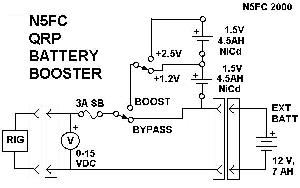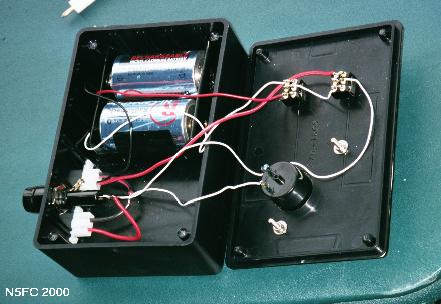N5ESE's QRP Battery Booster

(click on any picture to see larger version)
...more pix below...

(click on any picture to see larger version)
...more pix below...
| NOTE: 'N5FC' is my former call. This project was constructed while that call was valid, and you may observe references to it. |
Everybody that runs QRP with solid state rigs knows some of the potential problems that result when the battery you're using begins to lose it's charge. Most gear is designed (and specified) to run at 13.8 Volts. Power Output in non-ALC-controlled rigs is proportional to the square of the applied voltage. Even on a fully-charged lead-acid (gel-cell) battery, the loaded voltage will quickly fall to 12.5 V, and the output power will only be 80% of it's rated value. As the battery reaches about 1/2 of its rated capacity, voltage will drop to around 11 Volts, resulting in about 2/3 rated power. In many QRP rigs (including my Ten-Tec Scout), malfunctions or other performance problems occur below 12 Volts. To complicate matters, the cable between the rig and the battery may provide additional voltage drops, especially during transmit. For example, a 5-Watt QRP transmitter that uses 1 Amp of current during transmit, may lose an additional 0.1 to 0.5 Volts through a typical portable battery connection and cabling (most loss in the connectors).
The QRP Battery Booster here is an attempt to circumvent these problems. It was designed to be small, light, and portable, and work in conjunction with a 12 Volt battery for field day or portable operation. The idea is simple: when the 12 volt battery drops by 1.2 Volts, add a battery with similiar capacity and current-capability in series with the main battery, bringing the rig's operating voltage back up to nominal (or close to it). Here's a schematic:

To implement this, we procured a plastic project box from Radio Shack (RS 270-1806), which is large enough to hold 2 D-cells and their holder, with enough panel space to mount a panel-mounted voltmeter and two toggle switches. We'll arrange the circuitry so that we can switch in either one or two NiCad cells (although you could use Alkaline cells if the load current is not too high). A second switch will allow us to bypass the battery booster so that we don't have to physically remove it from the battery circuit. A picture of the front panel is shown at the very top (click on the image to see a larger version). Front panel labels were created using sticky-back paper (Avery 8-1/2 x 11 mail labels) and the trusty ol' PC & printer.
The 12-Volt battery input/output connectors are the ARES-recommended (Molex) connectors, panel-mounted using the connectors' integral mounting ears. The project box is pretty soft plastic, and it was easy to drill a rectangular pattern for the Molex connectors, then shape it out with a hobby knife (Wear Eye Protection!). My sloppy results are shown in the picture below. Notice also the fuse, which is intended to protect against short-circuiting the main battery.

The picture below shows the inside layout and wiring, which is completely non-critical. If you use battery-holders molded out of thermoplastics, I recommend getting two one-cell holders, with wires already attached, because the thermoplastics do not hold up well (at all) to soldering operations.

Operation is very simple. We assume you've installed two freshly-charged NiCad D-Cells. We prefer the 4500 mAH type (RS 23-140) even though they're very expensive, because they have about 3-times the capacity of standard cells, and have current sourcing capability similar to the main battery we'll be using. Connect the source battery (I use a 7AH, 12V gel-cell) to the input jack. Connect your QRP rig to the output jack. With the switch in "BYPASS" begin operation. Check the front-panel voltmeter from time to time, and when it drops below 12.5 Volts, switch in the first D-Cell "+1.2V". Wow! Back to full power! When it again drops below 12.5 Volts, switch it to both D-Cells "+2.5V". Again, back to full power! This is a really neat way to maximize your battery-operating capabilities.
When using this setup with my Ten-Tec 1340 (a 3-watt QRP rig) during Field Day '99, I operated for 21 hours, switched in the first D-cell after about 4 hours, and never got past the first D-Cell. Cool!
73,
Monty N5ESE
dit dididit dit